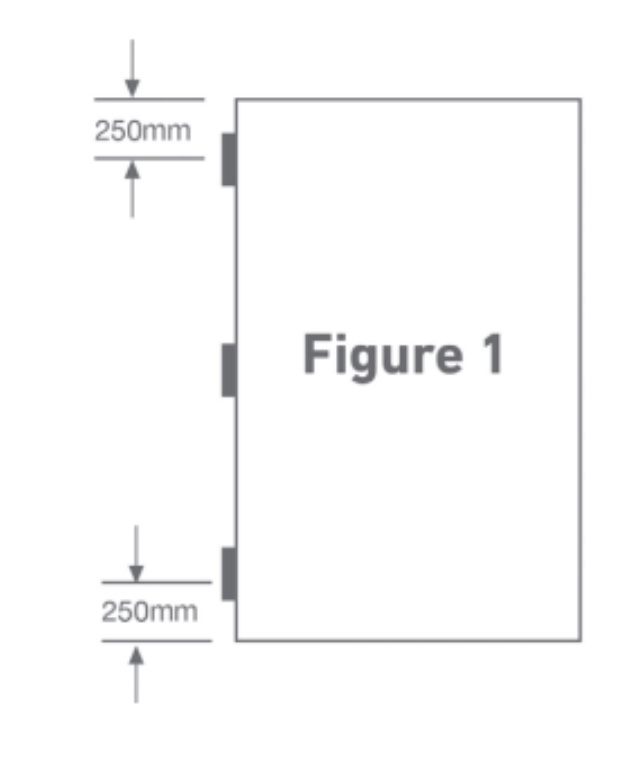Need Help? Contact Us Trade Customer? Register / Login
How Many Hinges Should a Fire Door Have?
When it comes to fire safety compliance, one often-overlooked detail is the number of hinges a fire door should have. Correctly installing hinges for fire doors is essential, not only for meeting UK fire door regulations, but also for ensuring that the door functions correctly in the event of a fire.
Fire door effectiveness depends on correct hardware, including the right number and type of fire-rated hinges.
In this guide, we break down how many hinges per door are typically required for fire doors, the reasoning behind these standards, and what kind of hinges should be used to remain compliant and protect lives and property.
What is a Fire Door?
Fire doors are doors with a fire-resistance rating which is used as part of a passive fire protection system to reduce the spread of fire and smoke between separate compartments of a structure and to enable safe egress. When the fire door is closed, it can stop any fire and smoke from spreading. The purpose of a fire door is to provide a safe and protected escape route while people evacuate the building, provide some protection for firefighters entering the building, and help limit the extent of damage to the building by containing any fire to the smallest area possible.
How Many Hinges Should a Fire Door Have?
According to fire door regulations in the UK, the vast majority of doors are tested with a minimum 3 hinges per door installed. The first hinge is fitted 250mm from the top, the second hinge 250mm from the bottom, and the third hinge is fitted in the middle of the door.
Please note that it’s essential to verify the fire test evidence for your door to confirm the fixing positions (the hinges must be installed according to the fire test evidence).


Why Are There Rules for Fire Doors?
A fire door must have fire test evidence to prove that it is a fire door. “Essential” ironmongery to be used on a fire door should have fire test evidence showing they have been tested on a similar construction of fire door.
Fire-rated hinges are tested with intumescent hinge pad liners fitted behind each leaf. In most cases, a 1mm thick pad is required for use on FD30-rated fire doors and a 2mm thick pad is needed for use on FD60-rated fire doors. These must be installed; however, it is essential to verify the fire test evidence for your door, as this can vary by manufacturer and door type.
The most common fire-rated hinge sold in the UK market is the Grade 13 ball bearing hinge, however, where possible, we highly recommend customers install polymer / nylon bearing hinges, which can take greater weights, have been tested to more cycles and do not contain any oil and require virtually no maintenance.
What are the European and British Standards for Testing?
The European standard for testing of fire doors is EN 1634 1
The British standard for testing of fire doors is BS 476 part 20-22 1987
Both EN 1634 1 and BS 476 standards are acceptable for fire door testing under Approved Document B and equivalents in UK and Ireland.
What Are the Fire Door Regulations and Requirements?
Buildings are split into “compartments” by fire-resisting walls, ceilings and floors. A fire door protects an opening in a fire wall and has the same level of fire resistance as the wall e.g. 30 or 60 minutes. Fire doors are found in most buildings, including new build houses, entrance doors and internal doors in flats and apartments, offices, schools, hospitals, in fact any public building.
New regulation under Article 24 of the Regulatory Reform (Fire Safety) Order 2005 - The Fire Safety (England) Regulations 2022.
As we’ve seen since the tragic events of Grenfell, fire doors play a vital role in protecting lives, and they must be inspected and maintained regularly to ensure they perform as initially tested.
From 23 January 2023, those responsible for all multiple-occupancy residential buildings in England with storeys over 11 meters in height must:
Quarterly checks of all fire doors (including self-closing devices) in the standard parts.
Annual checks of all flat entrance doors (including self-closing devices) that lead onto a building’s standard parts.
The regulations also require responsible persons to provide their residents in all multi-occupancy residential buildings with information on the importance of fire doors to a building’s fire safety.
Other Ironmongery Requirements for Fire Doors
The following items of ironmongery (door hardware) are deemed as “essential” and must be CE marked or UKCA marked on any new building or any door designated as door that needs to meet fire regulations:
Other hardware and ironmongery to complete these essential products include:
If you would like advice regarding hinges or ironmongery for fire-rated doors, please feel free to contact us, and one of GAI's trained teams will be happy to discuss various solutions for your project.
Keep Buildings Secure with Fire Door Hinges at G Johns & Sons
Durable hinges are essential for maintaining the security of fire doors. Choosing the right fire door hinges will ensure safety for buildings through maximising functionality.
At G Johns & Sons Ltd, we offer a range of fire door hinges that maximise safety and functionality, ensuring compliance with UK fire door regulations.
